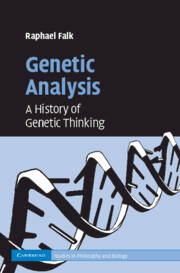Book contents
- Frontmatter
- Contents
- List of figures
- Acknowledgments
- Introduction
- PART I FROM REPRODUCTION AND GENERATION TO HEREDITY
- PART II FAKTOREN IN SEARCH OF MEANING
- PART III THE CHROMOSOME THEORY OF INHERITANCE
- 5 Chromosomes and Mendelian Faktoren
- 6 Mapping the chromosomes
- 7 Cytogenetic analysis of the chromosomes
- PART IV GENES AS THE ATOMS OF HEREDITY
- PART V INCREASING RESOLVING POWER
- PART VI DEDUCING GENES FROM TRAITS, INDUCING TRAITS FROM GENES
- PART VII WHAT IS TRUE FOR E. COLI IS NOT TRUE FOR THE ELEPHANT
- Concluding comments
- Bibliography
- Index
5 - Chromosomes and Mendelian Faktoren
Published online by Cambridge University Press: 07 August 2009
- Frontmatter
- Contents
- List of figures
- Acknowledgments
- Introduction
- PART I FROM REPRODUCTION AND GENERATION TO HEREDITY
- PART II FAKTOREN IN SEARCH OF MEANING
- PART III THE CHROMOSOME THEORY OF INHERITANCE
- 5 Chromosomes and Mendelian Faktoren
- 6 Mapping the chromosomes
- 7 Cytogenetic analysis of the chromosomes
- PART IV GENES AS THE ATOMS OF HEREDITY
- PART V INCREASING RESOLVING POWER
- PART VI DEDUCING GENES FROM TRAITS, INDUCING TRAITS FROM GENES
- PART VII WHAT IS TRUE FOR E. COLI IS NOT TRUE FOR THE ELEPHANT
- Concluding comments
- Bibliography
- Index
Summary
The involvement of chromosomes as bearers of hereditary continuity had been proposed as early as in the 1880s, when cytologists and embryologists unraveled the processes of fertilization and cell division at mitosis and meiosis. “Only with the recognition that a continuum of structure must be preserved during the development of the individual did heredity assume its modern and more narrow meaning of Vererbung, or transmission” (Churchill, 1987, 364). The dispute over the facts was bitter, but that over the speculations and theories on the meaning of these processes was even more acrimonious. Most daring in his speculations was August Weismann. Weismann's concern with the theoretical problem of deriving totipotent germ cells from a mature organism with differentiated cells led him to argue that germinal cells are transmitted undisturbed from cell to cell in the germ line. He assumed that in the soma cells the chromosomes break down transversely into numerous particles or biophores, and different assortments are farmed out to the cells, which differentiate according to the biophores allocated to them. In the cells of sexually reproducing species chromosomes may often be discerned in a species-specific pattern – there are two of each, one maternal and one paternal, they are diploid. Since the chromosome number in the germ line of all individuals of a species is identical, Weismann further speculated that at the “maturation division” (meiosis) of germ cells, the number of chromosomes is halved – they are haploid (Churchill, 1987).
- Type
- Chapter
- Information
- Genetic AnalysisA History of Genetic Thinking, pp. 77 - 93Publisher: Cambridge University PressPrint publication year: 2009



